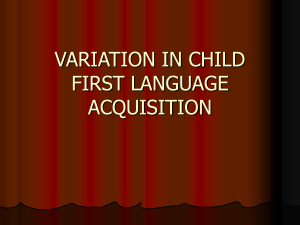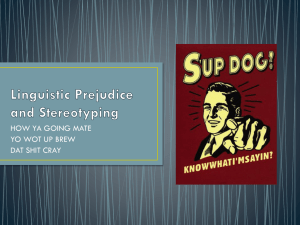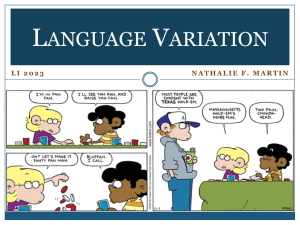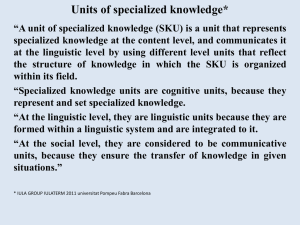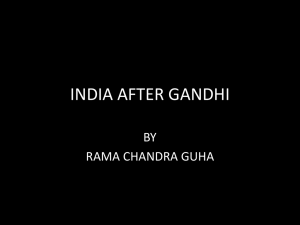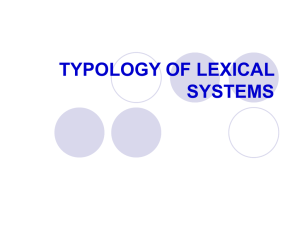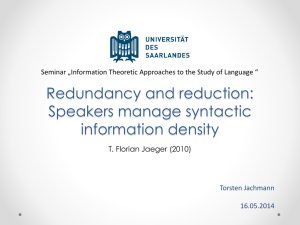Тема IV-10. Тема и рема. Исходный пункт. Подлежащее.
advertisement
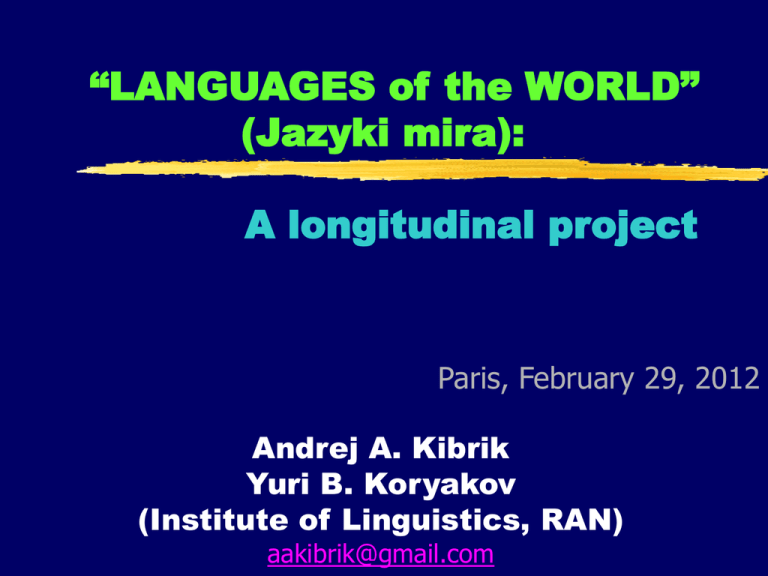
“LANGUAGES of the WORLD” (Jazyki mira): A longitudinal project Paris, February 29, 2012 Andrej A. Kibrik Yuri B. Koryakov (Institute of Linguistics, RAN) aakibrik@gmail.com “Languages of the World”: basic information Founded in mid-1970s by Viktoria N. Yartseva Motive: fragmented character of individual language descriptions, due to: actual linguistic differences various linguistic traditions personal preferences Goal: produce commensurable descriptions of as many human languages as possible Format: encyclopedia Languaqe: Russian 2 Template Tool: typologically-oriented, uncommitted template, including information on: external aspects of language: • • • • • history geography sociolinguistics dialects .......... • • • • • phonetics and phonology formal morphology representation of semantic categories syntactic constructions lexicon internal features: 3 Standard typologically-oriented templates Template I. Article on language family or group of dialects a.. Name b.. geographic spread and composition c.. Approximate number of speakers d.. Principles of genetic classification and its variants e.. Chronology of divergence (for higher level families) f.. Typical phonetic and grammatical features Bibliography II. Article on a language 1.1.0. Background information 1.1.1. alternative names 1.1.2. affilation (position in genealogical classification) 1.1.3. geographic spread; number of speakers 1.2.0. Linguo-geographical information 1.2.1. principal dialects 1.3.0. Socio-linguistic situation 1.3.1. communicative and functional status of the language 1.3.2. level of standartization 4 Properties of the template Positive very general • easily applicable to any language flexible • allows to fit in as much useful info as possible easy to use • numbered positions allow for efficient cross-referencing Negative somewhat outdated (developed in the 1970s) some overlap between positions There is no other choice than keep going with the template, as long as we are able to 5 1990s to now Switch from the encyclopedia format to individual volumes on language groups Since 1993 – 17 volumes on genealogical and areal language groupings One megaproject is split into a large number of much more graspable and managable individual projects Beginning from 2000s we integrate international colleagues and collect some articles in English 6 7 17 published volumes Uralic 1993 Turkic 1997 Mongolic, Tungusic, Japanese, and Korean 1997 Paleoasiatic 1997 South-western Iranian 1997 North-western Iranian 1999 Eastern Iranian 1999 Dardic and Nuristani 1999 Caucasian 1999 Germanic and Celtic 2000 Romance 2001 Old and Middle Indo-Aryan 2004 Slavic 2005 Baltic 2006 Semitic I Relict non-Indoeuropean languages of Near East New Indo-Aryan languages 8 Management Editorial group “Languages of the World” Constituent of the Institute of Linguistics, Russian Academy of Sciences 6 coworkers in the group Each project is managed by: Supervisor from the group “LW” “Genealogical editor(s)” Group of authors 9 Not yet published projects I. Near completion II. In the making III. Incipient stage IV. Projected 10 I. Near completion 18. Semitic II: Ethio-Semitic 19. Relict Indoeuropean languages of western and central Asia 20. Dravidian 21. Relict non-Indoeuropean languages of Europe 11 II. In the making 22. Austroasiatic and Andamanese 23. Mande 12 III. Incipient stage 24. Relict Indoeuropean languages of Europe 25. Sino-Tibetan 13 IV. Projected 26. Tai-Kadai 27. Miao-Yao 14 21 24 19 23 18 25 27 26 20 22 15 In toto 10 forthcoming volumes or more? 16 Applications Reference tool Educational instrument Tool for quantitative research 17 Database “Languages of the World” (Jazyki mira) Based on the encyclopedia Initiated in the 1980s Significantly advanced in the 2000s Vladimir Polyakov and Valery Solovyev 18 Features, JM p. 41 19 The database http://www.dblang.ru/en/Default.aspx About 350 languages, mostly Eurasia Relatively complete coverage of languages Hierarchically organized features 3800 binary features Over 1 million data points 20 Applications of the DB “Jazyki mira” typological studies areal-typological studies genealogical classifications of less-studied families shift from purely lexical basis for classification to the inclusion of grammatical properties contribution of areal and genealogical factors diachronic studies: language evolution and language prehistory 21 DB “Jazyki mira” and WALS Polyakov V., Solovyev V., Wichmann S., Belyaev O. Using WALS and Jazyki mira. Linguistic Typology. V. 13. 2009. P. 135– 165. 22 Hebrew Modern Persian Nenets Itelmen Chukchi Lezgian Abkhaz Kabardian Burushaski Bengali Chechen Georgian Ket Khanty Selkup Uzbek Tatar Bashkir Chuvash Azerbaijani Phylogenetic tree, WALS (Solovyev 2011) Kirghiz Hungarian Finnish Ukrainian Icelandic Russian Polish Czech Komi Zyrian Bulgarian Breton Danish Sw edish Dutch French Portugese Italian Catalan 23 0.05 Ukrainian Czech Phylogenetic tree, JM Russian Polish Bulgarian Burushaski Kabardian Hebrew Modern Bengali Itelmen Abkhaz Chukchi Ket Georgian Khanty Komi Zyrian Hungarian Finnish Selkup Nenets Chechen Tatar Chuvash Uzbek Azerbaijani Bashkir Kirghiz Lezgian Persian Breton Italian Catalan Dutch Portuguese French Icelandic Danish Sw edish 0.05 24 Language maps Authored by Yuri Koryakov http://lingvarium.org/maps.shtml Each volume is accompanied by a series of maps 25 Language maps vs. Linguistic maps Language maps demonstrate the spread of languages, or of their dialects, unified by: common territory (Language Atlas of China. S. A. Wurm et al. (eds). 1987) common genealogical affiliation (Коряков Ю.Б. Атлас кавказских языков) another common characteristic (Atlas of Languages of Intercultural Communication in the Pacific, Asia, and the Americas, 1996). Linguistic maps demonstrate the spread of linguistic phenomena, by means of dots, isoglosses, or areas within one language (e.g. on dialectological maps) in one region (e.g. Общеславянский лингвистический атлас 1965–2011, Atlas Linguarum Europae 1975–2002) world-wide (WALS 2005/2008) 26 Some language maps are quite general, such as this map of Tibeto-Burman 27 While some are very focused, such as this map of Jewish-Aramaic languages 28 Applications of language maps They serve as a visualization accompanying language description Particularly useful in the studies in linguistic geography, areal typology, dialectology The very process of mapping encourages linguists to pay close attention to many specific aspects of language description 29 Visual illustrations for language descriptions Languages of Eastern Caucasus Source: Authier G. Grammaire kryz (Langue caucasique d'Azerbaïdjan, dialecte d'Alik). Paris: Peeters, 2009. Reduction of the Vodic territory in the 20th century Source: Агранат Т.Б. Западный диалект водского языка. Mitteilungen der Societas Uralo-Altaica 26. Москва – 30 Гронинген, 2007 Production of this map provoked the editors of the Indo-Aryan volume to substantially correct and expand linguo-geographical information Source: Языки мира: Новые индоарийские языки. ― М.: Academia, 2011. 31 Phenomena resistent to mapping: multilingualism, social / age-related / community-related distribution of speakers, decay of languages/dialects Complex linguistic situation in Istria and adjacent areas Gradual decay of French dialects Source: Atlas of Romance languages. Moscow, 2001. 32 Maps may be combined with other representations, e.g. classification schemes Source: Atlas of Romance languages. Moscow, 2001 33 Creation of language maps When creating language maps, a variety of sources is used, including textual and cartographic There are several techniques used in the creation of language maps 34 Maps may rely on census data, on the communityby-community basis, subsequently generalized Linguistic profiles of individual communities Areas are generalized from communities 35 Maps for the forthcoming publication: Коряков Ю.Б. Атлас языков России Generalization accompanying scaling-down Sources: Коряков Ю.Б. Атлас кавказских языков. М., 2006; 36 Бурлак С.А. Сравнительно-историческое языкознание. М., 2005. Use of isoglottic maps for the identification of dialect boundaries Isoglottic map Dialect map Source: Ежегодный альманах еврейской музыкальной культуры «Музыка идишкайта». 2006. Isogloss data from: Herzog, Marvin, et al. ed., YIVO, The Language and Culture Atlas of Ashkenazic Jewry, 3 vols., Tübingen, 1992–2000. 37 Historical language maps Stage 1: Historic “base” Stage 2: Locations of finds Stage 3: Language boundaries Source: Языки мира: Семитские языки. Аккадский язык. Северозападносемитские языки. М., «Academia», 2009. 38 Our latest publication New Indo-Aryan languages. Ed. by Tatiana I. Oranskaia, Julia V. Mazurova, Andrej A. Kibrik, Leonid I. Kulikov, Aleksandr Y. Rusakov. 896 pp. 39

